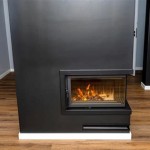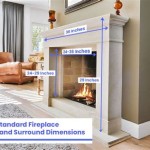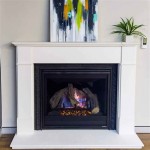Replacing a Gas Fireplace with a Wood Stove Insert: A Comprehensive Guide
Many homeowners with existing gas fireplaces consider switching to a wood stove insert. This conversion offers several potential advantages, including enhanced heating efficiency, reduced reliance on natural gas, and the traditional ambiance of a wood-burning fire. However, the process involves careful planning, adherence to building codes, and proper installation to ensure safety and optimal performance. This article provides a detailed overview of replacing a gas fireplace with a wood stove insert, outlining key considerations, steps involved, and essential safety precautions.
A wood stove insert is a self-contained wood-burning appliance designed to fit into the existing firebox of a fireplace. Unlike traditional open fireplaces, wood stove inserts are engineered for greater efficiency, burning wood more completely and extracting more heat for the same amount of fuel. This increased efficiency translates to lower heating costs and reduced environmental impact, especially in areas where wood is a readily available and sustainable resource. Furthermore, modern wood stove inserts are equipped with advanced combustion technology, reducing smoke emissions and meeting stringent air quality standards.
Assessing Compatibility and Feasibility
Before embarking on a wood stove insert installation, a thorough assessment of the existing gas fireplace and chimney is crucial. This assessment determines the feasibility of the conversion and identifies any necessary modifications or repairs. Several factors must be considered:
Fireplace Dimensions and Construction: The dimensions of the existing firebox must be measured accurately to ensure that the selected wood stove insert fits properly. The width, height, and depth of the firebox opening, as well as the depth of the fireplace itself, are essential measurements. The construction material of the fireplace (e.g., brick, stone, concrete) should also be evaluated for structural integrity. Any cracks, crumbling mortar, or other signs of damage should be addressed before proceeding with the installation.
Chimney Condition and Liner Requirements: The chimney plays a critical role in safely venting combustion gases from the wood stove insert. A professional chimney inspection is highly recommended to assess the chimney’s condition. This inspection should include a visual examination of the chimney’s interior and exterior, as well as a check for obstructions, cracks, and deterioration. In most cases, the existing chimney will require a new stainless steel liner that is specifically sized and approved for use with the chosen wood stove insert. This liner ensures proper draft, prevents creosote buildup, and protects the chimney from the corrosive effects of combustion gases. The diameter of the liner is crucial for ensuring proper draft and efficient combustion; consult the wood stove insert manufacturer's specifications for the correct size.
Gas Line Disconnection and Removal: A qualified gas technician must disconnect and cap the gas line leading to the existing gas fireplace. This step is essential to prevent gas leaks and ensure safety. The gas logs and any other gas fireplace components should be removed from the firebox.
Clearances and Building Codes: Local building codes and regulations govern the installation of wood-burning appliances. It is imperative to obtain the necessary permits and comply with all applicable requirements. These codes often specify minimum clearances from combustible materials, such as walls, floors, and ceilings. The wood stove insert must be installed according to the manufacturer's instructions and in compliance with these clearance requirements to prevent fire hazards. Check with your local building department for specific requirements in your area. Failure to comply with building codes can result in fines and require the removal of the appliance.
Selecting the Right Wood Stove Insert
Choosing the appropriate wood stove insert is crucial for achieving optimal heating performance and meeting individual needs. Several factors should be considered during the selection process:
Heating Capacity: Wood stove inserts are rated by their heating capacity, typically expressed in British Thermal Units (BTUs). The required BTU rating depends on the size of the area to be heated, the climate, and the insulation levels of the home. A larger space or a colder climate will require a wood stove insert with a higher BTU rating. Consult with a heating professional to determine the appropriate BTU rating for your specific needs.
Efficiency Rating: The efficiency rating of a wood stove insert indicates how effectively it converts wood into usable heat. Higher efficiency ratings translate to lower fuel consumption and reduced heating costs. Look for wood stove inserts with an EPA (Environmental Protection Agency) certification, which indicates that the appliance meets stringent emission standards and operates efficiently. EPA-certified wood stoves are significantly cleaner-burning than older, non-certified models.
Firebox Size and Wood Length: The size of the firebox determines the length of wood that can be accommodated. Consider the availability and cost of different wood lengths in your area when selecting a wood stove insert. A larger firebox will allow for longer burn times and less frequent refueling.
Features and Aesthetics: Wood stove inserts are available in a variety of styles and finishes to complement different home décor. Features such as blowers, catalytic combustors, and air wash systems can enhance performance and ease of use. Blowers circulate heated air more effectively throughout the room, while catalytic combustors reduce emissions and increase efficiency. Air wash systems help keep the glass door clean, providing a clear view of the fire.
Installation Process: A Step-by-Step Guide
Installing a wood stove insert is a complex process that requires specialized knowledge and skills. While some experienced homeowners may choose to undertake the installation themselves, professional installation is strongly recommended to ensure safety and compliance with building codes. The following steps outline the general installation process:
Preparing the Fireplace: The existing gas fireplace components must be removed, and the firebox should be cleaned thoroughly. Any debris, soot, or creosote should be removed to ensure proper fit and airflow. The gas line should be properly capped by a qualified technician.
Installing the Chimney Liner: The stainless steel chimney liner is typically installed by lowering it down the chimney from the top. The liner is connected to the wood stove insert using a connector pipe. Proper insulation around the liner is crucial to maintain draft and prevent condensation. The liner should extend beyond the top of the chimney and be capped with a suitable chimney cap to prevent rain and debris from entering.
Positioning the Wood Stove Insert: The wood stove insert is carefully positioned inside the firebox. Ensure that the insert is level and properly aligned. Follow the manufacturer's instructions for securing the insert in place. Proper sealing between the insert and the fireplace opening is essential to prevent air leaks and ensure efficient operation. This is often accomplished with a ceramic fiber gasket.
Connecting the Stove to the Liner: Connect the wood stove insert to the chimney liner using a connector pipe. This pipe should be securely attached to both the insert and the liner. Seal all joints with high-temperature sealant to prevent leaks. Ensure that the connector pipe is properly sized and positioned to maintain adequate draft.
Installing the Surround Panel: The surround panel is a decorative piece that covers the gap between the wood stove insert and the fireplace opening. The surround panel provides a finished look and helps to prevent air leaks. Install the surround panel according to the manufacturer's instructions.
Testing and Safety Check: After installation, a thorough testing and safety check is essential. Ensure that the wood stove insert is operating properly and that there are no leaks or other issues. Check the draft to ensure that smoke is being vented properly up the chimney. Carbon monoxide detectors should be installed in the home to provide an early warning of any carbon monoxide leaks. A professional inspection is recommended to ensure that the installation meets all safety requirements.
Safety Considerations and Maintenance
Operating a wood stove insert safely requires adherence to several important guidelines:
Proper Wood Storage: Store firewood in a dry, well-ventilated area away from the house. Season wood for at least six months before burning it. Burning unseasoned wood can lead to creosote buildup and increased smoke emissions.
Safe Burning Practices: Never use flammable liquids to start a fire. Use kindling and small pieces of wood to gradually build up the fire. Avoid overfilling the firebox, as this can lead to excessive smoke and potentially dangerous conditions. Always keep the stove door closed when the fire is burning.
Regular Chimney Cleaning: Creosote is a flammable substance that can accumulate in the chimney and pose a serious fire hazard. The chimney should be inspected and cleaned regularly by a qualified chimney sweep. The frequency of cleaning depends on the amount of wood burned and the type of wood used. Most professionals recommend an annual inspection and cleaning.
Carbon Monoxide Detection: Install carbon monoxide detectors on every level of the home, especially near sleeping areas. Test the detectors regularly to ensure that they are functioning properly. Carbon monoxide is a colorless, odorless gas that can be deadly. Symptoms of carbon monoxide poisoning include headache, dizziness, nausea, and fatigue.
Ash Removal: Remove ashes from the wood stove insert regularly. Store ashes in a metal container with a tight-fitting lid. Dispose of ashes properly, away from combustible materials.

Want To Convert Gas Wood Fireplace Full Service Chimney

Can You Convert A Gas Fireplace To Wood Burning Stove Direct Stoves Resources
Converting A Wood Burning Fireplace Into Gas Heat Glo

Convert From Wood To Gas With A Insert The Kernel Burner

Convert To Gas Installing Fireplace Inserts Doctor Flue

Fireplace Insert Guide Fireplaces Direct Learning Center

Want To Convert Gas Wood Fireplace Full Service Chimney

What S Best A Fireplace Stove Or Insert We Love Fire

Can A Wood Burning Fireplace Be Converted To Gas The Flame Company
How To Install Gas Fireplace Insert Heat Glo
Related Posts








